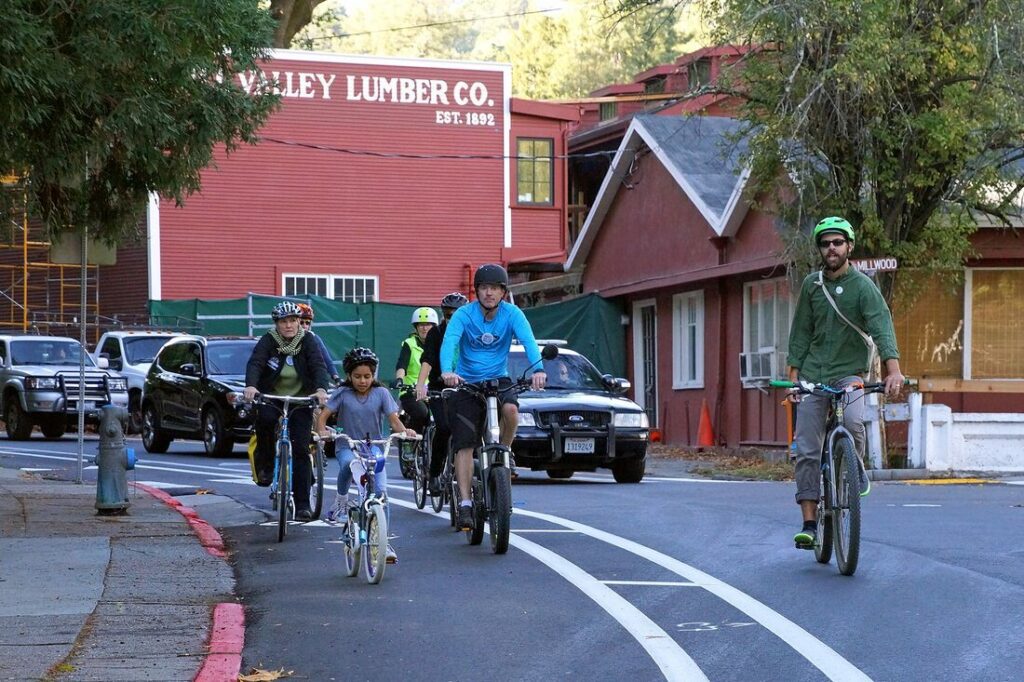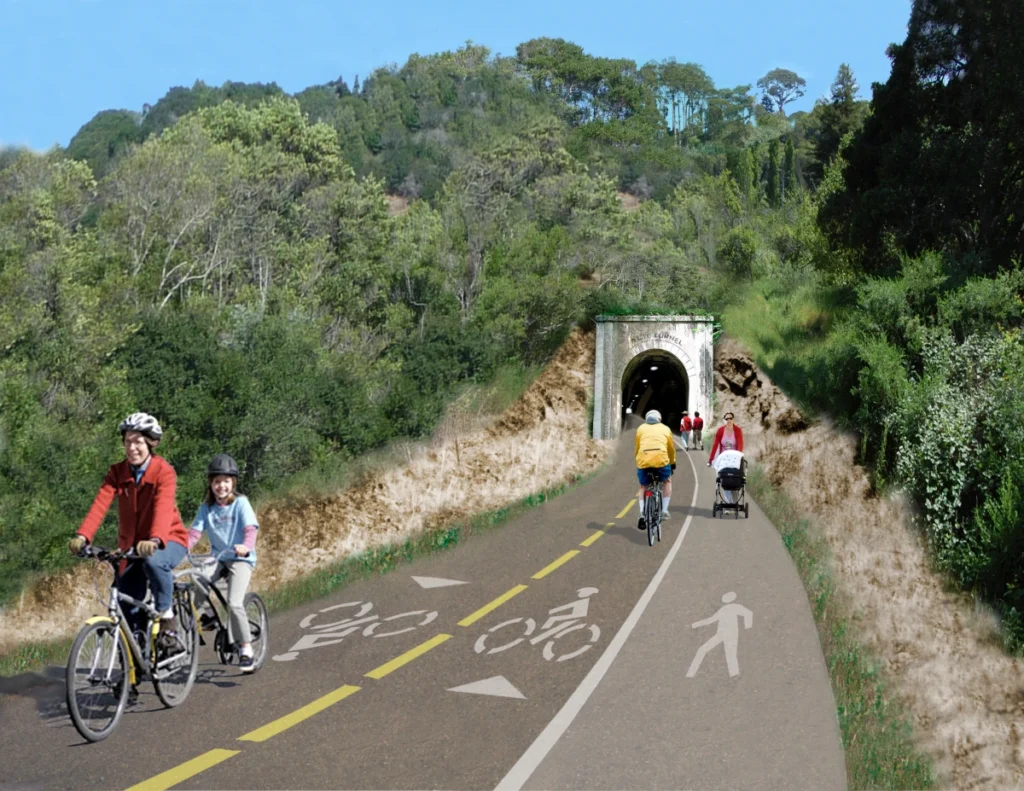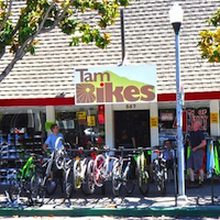 As Mill Valley residents know well, there’s no doubt that the volume of people cruising on two wheels around Mill Valley over the past several years has taken off like a rocket ship. The primary driver of that increase has been pretty clear: safety.
As Mill Valley residents know well, there’s no doubt that the volume of people cruising on two wheels around Mill Valley over the past several years has taken off like a rocket ship. The primary driver of that increase has been pretty clear: safety.
The City of Mill Valley‘s 18-month, $18 million Miller Avenue Streetscape Project in 2016 was a beast, a once-in-generation re-imagining of approximately two miles of one of Mill Valley’s two main arteries and far and away the biggest road improvement project the City had undertaken in decades.
But as is is evident from a stroll on Miller Avenue or the Mill Valley-Sausalito multi-use path just about any time of day, the popularity of bikes, e-bikes and cargo bikes has exploded in recent years, and looks to continue to surge for years to come. The forecast calls for the e-bike market to generate around 51.78 billion U.S. dollars in revenue by 2029, with a compound annual growth rate of around eight percent between 2024 and 2029, according to Statista.
If You Make It Safe, They Will Come
The amount of families and kids of all ages riding on Miller says it all. Safety has cascading effects, drawing visitors from other parts of the Bay Area and beyond without adding to car traffic, and allowing residents and visitors to more easily connect via bike to neighboring communities. For instance, Class IV bike lanes on Blithedale have made progress toward a protected bike route linking the Mill Valley-Sausalito Pathway with Tiburon’s Old Rail Trail in order to create a seamless connection between two of Marin’s most popular multi-use pathways. Caltrans is scheduled to repave the stretch east of 101 in 2024.
That links looks to grow in the near future. According to the Marin IJ, the California Transportation Commission has allocated $7.5 million for road improvement work in Marin, and the plan includes the largest project of the bunch: a $23 million effort to improve Tiburon Boulevard with bicycle lanes and pedestrian upgrades. The project is expected to be completed in three segments beginning in January 2026 and lasting about a year.cThe project also aims to improve ride quality and support active modes of transportation such as biking, he said.
The plan calls for upgrading or replacing guardrails, road signs and drainage and electrical systems. It also includes upgrading curbside ramps to be compliant with the Americans with Disabilities Act, repaving roads and adding bike lanes. The western segment of the project, from Tower Drive in Mill Valley to Reed Ranch Road in Tiburon, includes changes to two intersections. At East Strawberry Drive, the right turn lane onto eastbound Tiburon Boulevard would be removed and the existing bus stop on Tiburon Boulevard would be relocated.
Class IV bikeways would be added along Tiburon Boulevard from approximately 1,000 feet west of the freeway to Trestle Glen Boulevard. A class I bikeway at East Strawberry Drive to Greenwood Cove Drive is also planned. The central section of the project, spanning from Reed Ranch Road to San Rafael Avenue, includes adding a class IV bike lane from Reed Ranch Road to Trestle Glen Boulevard. The Avenida Miraflores and Tiburon Boulevard intersection would be altered to remove the right turn lane from westbound Tiburon Boulevard onto northbound Avenida Miraflores.
The eastern section, from San Rafael Avenue to the intersection of Tiburon Boulevard and Main Street, includes a curb extension at the Mar West Street intersection. It also would add yield lines to the Ned’s Way and Tiburon Boulevard intersection.
Needless to say that the trajectory for the local and regional bike network is laden with possibility.
And lucky for local bike lovers – Tam Bikes remains the local stalwart and we’ve seen Pacos Bikes at 31 Miller Ave. take over the space formerly occupied by Studio Velo, and Epicenter Cycling move into 18 Miller Ave., (formerly Wells Fargo).
But there appears more to be excited about beyond increased usage and more safety measures for cyclists.
Cycling on Marin Water Land?
MMWD has indicated that it is exploring pilot programs for expanded bike access. The district’s watershed committee decided at a meeting on March 21 that the draft study was ready to be formalized by the board. “After 50-plus years of riding my bike on this mountain, I am very pleased that I will no longer be a second-class citizen,” Andrew Levine of Mill Valley said.
“I’m excited,” said Rick Jones, a cyclist and member of the Access for Bikes advocacy group. He said that 20 and 30 years ago, cyclists were fractionalized, but after organizing everyone is “environmentally focused.”
While mountain bikers and e-bike advocates are enthused, the plan is a sensitive topic for many who have hiker safety and the environment in mind, specifically with e-bikes in mind. Nona Dennis, a representative of the Marin Conservation League, said the environmental organization is not opposed to bicycles. However, she said, its members are interested in safe speeds on trails, and she would also like to know where officials are considering bike access.
Board member Jed Smith said that ahead of the March 21 meeting he came across an article from 1999 that highlighted that the trails were used by more than 2 million people, but the issues were the same then as they are now. “The only thing that changed in the article were the names that were quoted,” he said. “There has be no update of our recreation oversight.”
Smith said he supports the plan. “I believe it is thoughtful, balanced and incremental,” he said. “It is not a radical shift. It is led by stewardship of our critical habitat, our mission to ensure clean, safe, affordable drinking water.”
Richmond Bridge Bike Use to Be Scaled Back?
Regulators are contemplating dramatic constraints for a 4-mile bike path along the Richmond-San Rafael Bridge, long a source of controversy between cyclists and motorists, according to the San Francisco Chronicle likely to be limited to use limited from Friday through Sunday.
“This is an effort to strike a compromise between the interests of bicyclists and pedestrians, and the interests of the vastly greater number of people who travel through the corridor by car,” said John Goodwin, spokesperson for the Metropolitan Transportation Commission, which operates the Bay Area’s seven state-owned toll bridges.
MTC’s automated counters record 80 bike trips on an average weekday, compared with 232 on Saturdays and Sundays. Some drivers felt tantalized, peering out their windows to see a line of concrete barriers — and beyond them, a 10-foot wide roadway that cars can’t access.
The White Whale of Marin Cycling Gets a Bit of Momentum
 With all of the bike-related success in Marin County in recent years, there remains a deep desire among diehards to move forward with the long-stalled Alto Tunnel campaign. It’s “a late-1800s railroad tunnel that has been shuttered since 1971 and now sits partially collapsed awaiting its final fate; total collapse or renewed life as a key part of the long-awaited North-South Greenway. The hope is to connect Mill Valley to Corte Madera, and complete a greenway from southern to northern Marin, enabling people of all ages and abilities, whatever their purpose – commuting, transportation, exercise, recreation – to walk, bike, and roll safely and efficiently, enjoying the beauty of our communities for generations to come,” according to Alto Tunnel supporters.
With all of the bike-related success in Marin County in recent years, there remains a deep desire among diehards to move forward with the long-stalled Alto Tunnel campaign. It’s “a late-1800s railroad tunnel that has been shuttered since 1971 and now sits partially collapsed awaiting its final fate; total collapse or renewed life as a key part of the long-awaited North-South Greenway. The hope is to connect Mill Valley to Corte Madera, and complete a greenway from southern to northern Marin, enabling people of all ages and abilities, whatever their purpose – commuting, transportation, exercise, recreation – to walk, bike, and roll safely and efficiently, enjoying the beauty of our communities for generations to come,” according to Alto Tunnel supporters.
On March 19th, supporters presented a petition with over 2,000 signatures along with a letter of support co-signed by two dozen organizations and businesses, to the Marin County Board of Supervisors.
“No other project before you right now has the potential to save emissions like this project could,” Tarrell Kullaway, Executive Director of MCBC and Vice Mayor Town of San Anselmo, told the supervisors. “I believe we have the courage in this room to take the next step – yes, there will be issues, but let’s prioritize working through them. Like no other time in our history, money is coming down from the feds for exactly these types of projects. Would we rather the money be spent in another county or here?”
County Buys Former 157-Acre Golf Course

Courtesy of the Trust for Public Land
Lastly, the Marin County Board of Supervisors this week unanimously approved a purchase agreement between the County of Marin and The Trust for Public Land for the long-defunct, 157-acre golf course on Sir Francis Drake Boulevard. The national conservation organization purchased the property for $8.85 million when the 18-hole municipal course closed in 2017. Under the agreement, the county will pay $4.5 million for the 22-acre clubhouse parcel, according to Guillermo Rodriguez, the trust’s California state director.
The property would be maintained by the Marin County parks district. It is not expected to be developed into a built park, with pools, sport courts or other amenities, said a county spokesperson.
The property is on both sides of Sir Francis Drake Boulevard, and 22 acres at the corner of Nicasio Valley Road would be carved out for the Marin County Fire Department. This parcel includes the vacant San Geronimo Golf Course clubhouse, which is the only modern structure on the property.
The land now serves as a conservation easement known as San Geronimo Commons. It is open to the public as a passive park, used by hikers, bikers and equestrians as green space linking trails from the Golden Gate National Recreation Area to Point Reyes National Seashore. It connects to Roy’s Redwoods Open Space Preserve.


Thank you for such a thoughtful and well-reached article